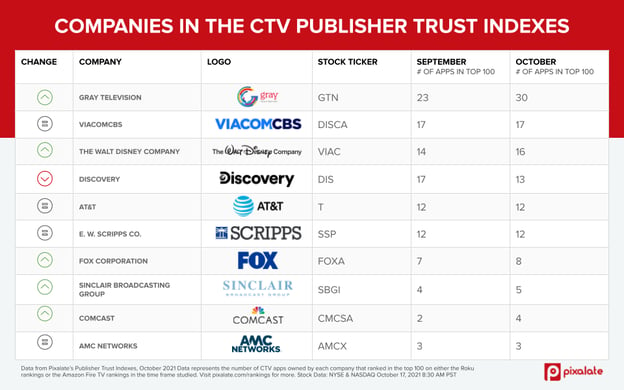
Gray Television (GTN) remained the leader of publicly traded companies owning the most significant number of high-quality CTV apps for advertisers, based on Pixalate’s analysis of the Publisher Trust Indexes for Roku and Amazon Fire TV platforms in October 2021 in North America.
With 30 apps in October, Gray Television noted the highest increase of apps ranked in both CTV Publisher Trust Indexes among all publicly traded companies. Interestingly, all 30 apps owned by Gray Television were classified in the top 100 of the Amazon Fire TV Publisher Trust Index.
The rise from 23 in September to 30 in October was the most significant among all publicly traded companies owning CTV apps ranked in the top 100 of the CTV Publisher Trust Indexes. Gray Television achieved it by improving programmatic advertising quality in their portfolio of local news TV channels, including WSAZ, WKYT News, and WITN News.

ViacomCBS and The Walt Disney Company at the podium
ViacomCBS (VIAC) and The Walt Disney Company (DIS) obtained the second and third positions in the ranking with 17* and 16 apps, respectively.
For ViacomCBS, the number of apps in the CTV Publisher Trust Indexes remained the same as in September. There are channels in the company’s portfolio, such as MTV, VH1, and Comedy Central.
On the other hand, The Walt Disney Company narrowed the gap between them and ViacomCBS and had two more apps in the October CTV Publisher Trust Indexes than in September. Hulu, ABC News, and ESPN are some of the most popular channels owned by the company.
In October 2021, 128 apps of the top 200 were owned by publicly traded companies (Top 100 Roku and Top 100 Amazon Fire TV rankings). In Roku’s classification, there were 50 apps owned by publicly traded companies, in Amazon’s - 78. Compared to September, the number of apps in Roku’s ranking increased from 42. For Amazon, the status quo remained.
*Two apps are co-owned 50/50 by ViacomCBS and AT&T and were included in the count of both companies.
Disclaimer
The content of this blog, and the Publisher Trust Indexes (collectively, the “Indexes”), reflect Pixalate’s opinions with respect to factors that Pixalate believes may be useful to the digital media industry. The Indexes examine programmatic advertising activity on mobile apps and Connected TV (CTV) apps (collectively, the “apps”). As cited in the Indexes and referenced in the Indexes’ key findings reproduced herein, the ratings and rankings in the Indexes are based on a number of metrics (e.g., “Brand Safety”) and Pixalate’s opinions regarding the relative performance of each app publisher with respect to the metrics. The data is derived from buy-side, predominantly open auction, programmatic advertising transactions, as measured by Pixalate. The Indexes examine global advertising activity across North America, EMEA, APAC, and LATAM, respectively, as well as programmatic advertising activity within discrete app categories. Any insights shared are grounded in Pixalate’s proprietary technology and analytics, which Pixalate is continuously evaluating and updating. Any references to outside sources in the Indexes and herein should not be construed as endorsements. Pixalate’s opinions are just that, opinions, which means that they are neither facts nor guarantees; and neither this press release nor the Indexes are intended to impugn the standing or reputation of any person, entity or app.
*By entering your email address and clicking Subscribe, you are agreeing to our Terms of Use and Privacy Policy.
These Stories on CTV
*By entering your email address and clicking Subscribe, you are agreeing to our Terms of Use and Privacy Policy.

Disclaimer: The content of this page reflects Pixalate’s opinions with respect to the factors that Pixalate believes can be useful to the digital media industry. Any proprietary data shared is grounded in Pixalate’s proprietary technology and analytics, which Pixalate is continuously evaluating and updating. Any references to outside sources should not be construed as endorsements. Pixalate’s opinions are just that - opinion, not facts or guarantees.
Per the MRC, “'Fraud' is not intended to represent fraud as defined in various laws, statutes and ordinances or as conventionally used in U.S. Court or other legal proceedings, but rather a custom definition strictly for advertising measurement purposes. Also per the MRC, “‘Invalid Traffic’ is defined generally as traffic that does not meet certain ad serving quality or completeness criteria, or otherwise does not represent legitimate ad traffic that should be included in measurement counts. Among the reasons why ad traffic may be deemed invalid is it is a result of non-human traffic (spiders, bots, etc.), or activity designed to produce fraudulent traffic.”

